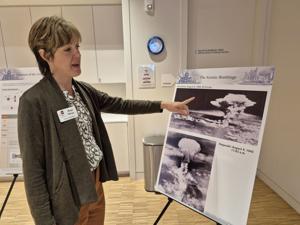The Corvallis Museum is currently hosting a profoundly significant exhibit, marking the 80th anniversary of the atomic bombings of Hiroshima and Nagasaki. This meticulously curated display serves not only as a historical retrospective but also as a poignant educational endeavor, inviting visitors to deeply reflect on the devastating impact of atomic warfare and the enduring quest for global peace.
Eighty years ago, on August 6, 1945, at precisely 8:15 a.m., the world bore witness to an unparalleled moment of destruction as the first atomic bomb was unleashed upon Hiroshima, Japan. This catastrophic event claimed countless lives, including that of three-year-old Shinichi, whose brief existence tragically embodies the innocent lives abruptly ended by the unprecedented power of nuclear weapons. The exhibit vividly portrays the immediate and long-term consequences of this singular act.
While the passage of time often dims collective memory, the Corvallis Hiroshima Nagasaki Commemoration Committee has tirelessly worked for years to ensure that local residents remain acutely aware of this grim anniversary. Their unwavering dedication ensures that the profound lessons of 1945 are not only remembered but actively used to foster dialogue and understanding within the community.
A cornerstone of this exceptional Corvallis exhibit is the invaluable collaboration with the Hiroshima Peace Memorial Museum in Japan. Curators from the esteemed Japanese institution have generously provided 30 powerful displays, featuring an extensive collection of photographs that span a spectrum from purely informational historical records to harrowing depictions of the bomb’s immediate aftermath, underscoring its dual nature of documenting and evoking empathy.
These photographic materials, though not including original artifacts like Shinichi’s tricycle—a haunting symbol preserved in Japan—are nonetheless jarring in their raw portrayal of human suffering and resilience. They compel viewers to confront the stark realities of war, illustrating the importance of commemorating such events to prevent future atrocities and promote a more peaceful future.
Beyond the static displays, the Corvallis commemoration extends to various community activities designed to engage the public. Recent events included a serene procession of illuminated vessels along the Willamette River, symbolizing hope and remembrance, complemented by the distribution of thousands of vibrant paper cranes, folded by survivors. This act honors the legacy of 12-year-old Sadako Sasaki, whose personal battle with radiation poisoning and her aspiration to fold 1,000 cranes became a global emblem of peace and perseverance.
Recognizing the sensitive nature of some exhibit content, the Corvallis Museum has thoughtfully organized a Family Peace Day alongside the primary display. This dedicated event offers a more gentle approach for younger visitors and families, focusing on activities like paper crane folding and listening to songs of peace, ensuring that the critical message of the atomic bomb’s legacy is conveyed appropriately across all age groups.
The Corvallis Museum expresses profound gratitude and honor for the opportunity to host this compelling exhibit. The steadfast support and shared vision from the Hiroshima Peace Memorial Museum underscore a collective commitment to sharing this vital historical narrative, aiming to inspire global reflection on peace, conflict, and the enduring human spirit in the face of immense adversity.






Leave a Reply